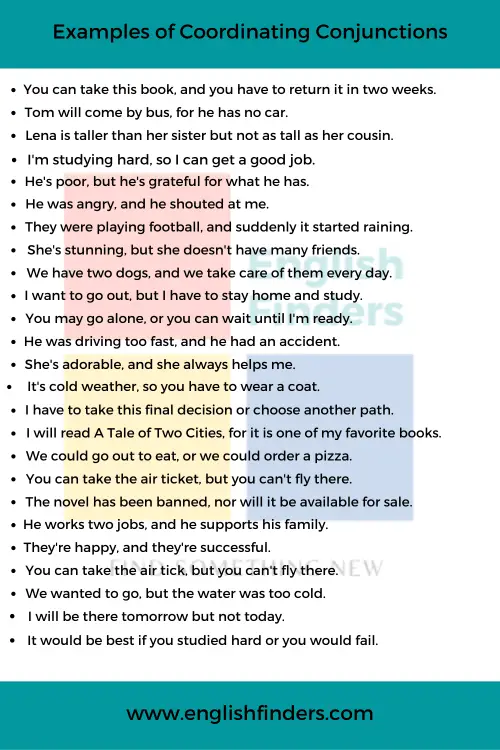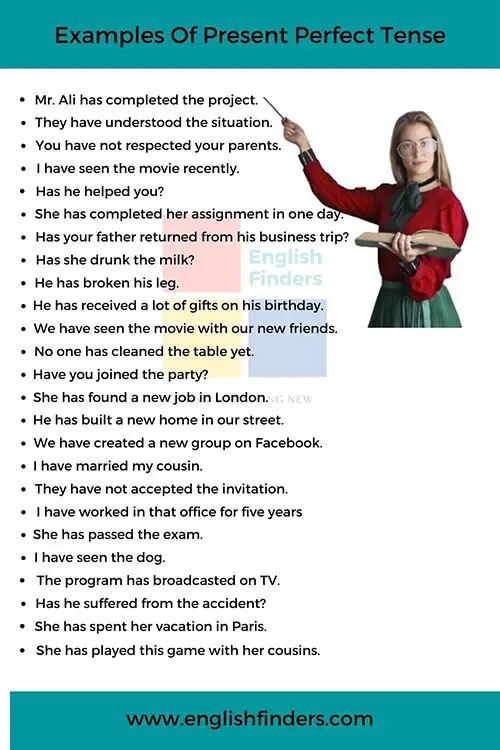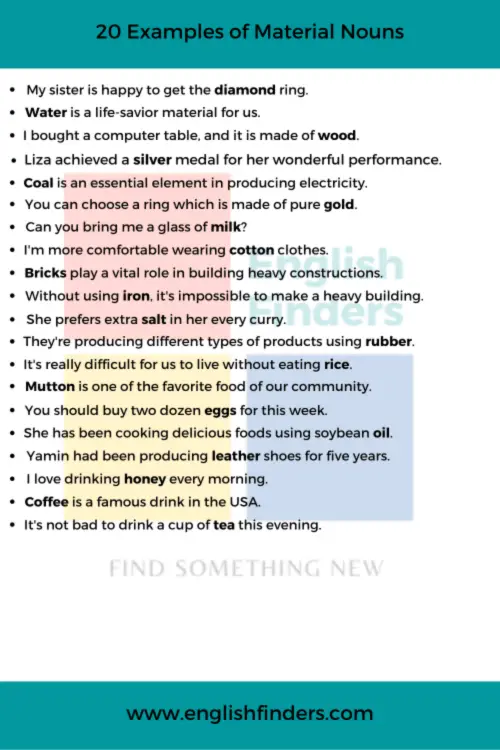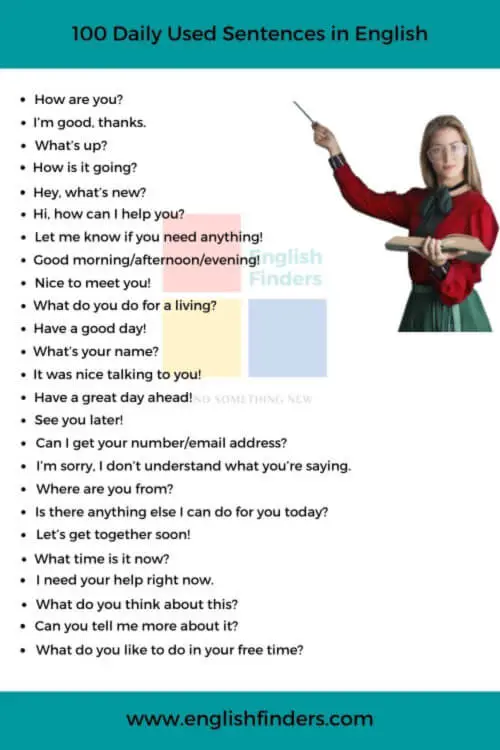Last updated on June 3rd, 2025 at 03:26 pm
A coordinating conjunction is a word that connects words, phrases, or two independent clauses. It helps to clarify the relationship between the two clauses and makes the sentence easier to read. In this blog post, we will discuss 50 examples of coordinating conjunctions.
You may have already heard of the popular acronym FANBOYS — it stands for For, And, Nor, But, Or, Yet, So. These seven words are the core of coordinating conjunctions. They make your sentences flow better and your ideas connect more clearly.
What Are Coordinating Conjunctions?
Quick Navigation

Coordinating conjunctions are words that connect two or more parts of a sentence that are equal or similar. These parts can be words, phrases, or even complete sentences (independent clauses). The main job of coordinating conjunctions is to keep your ideas organized and easy to understand.
There are seven coordinating conjunctions, and you can remember them using the word FANBOYS:
- F – For
- A – And
- N – Nor
- B – But
- O – Or
- Y – Yet
- S – So
Each of these words plays a special role in a sentence. Let’s look at a simple example:
👉 I wanted to go to the supermarket, but the weather is hot.
In this sentence, the word but connects two complete thoughts and shows contrast.
Here’s another one:
👉 She likes apples and bananas.
Now and is used to join two similar items.
As you can see, coordinating conjunctions help your sentences flow naturally and clearly.
Why Are Coordinating Conjunctions Important?
Coordinating conjunctions may be small words, but they do a big job in helping you speak and write more clearly. Let’s explore why they matter so much in English.
🧩 1. They Connect Ideas Smoothly
Without coordinating conjunctions, your sentences might sound broken or confusing. These words help link your thoughts so they make sense together. For example:
👉 I love reading and writing.
This sentence connects two hobbies in a smooth and natural way.
🗣️ 2. They Make Sentences Easier to Understand
By using coordinating conjunctions, your reader or listener can easily follow your message. These words help your sentences flow, which makes communication more effective.
👉 He was tired, so he went to bed early.
Here, the word so clearly shows the reason behind his action.
🔄 3. They Add Variety to Your Writing
Instead of using short, choppy sentences, coordinating conjunctions allow you to combine ideas. This keeps your writing interesting and engaging.
👉 You can watch a movie, or you can play a game.
This gives options and makes the sentence more complete.
🧠 4. They Help You Think in English
When you get used to using conjunctions like but, yet, and or, you start thinking in full sentences. That’s a big step toward fluency!
The 7 Coordinating Conjunctions Explained
Now that you know what coordinating conjunctions are and why they’re important, let’s take a closer look at the seven FANBOYS. Each one connects ideas in a different way. Below, you’ll find a simple explanation and a few easy-to-understand examples for each.
1. For – shows reason or cause
The word for explains why something happens. It’s similar to the word “because.”
✅ Examples:
- She stayed home, for she wasn’t feeling well.
- I took an umbrella, for it looked like rain.
2. And – adds similar ideas
Use and when you want to join two similar things or ideas.
✅ Examples:
- I like cold coffee and drinks.
- He washed the dishes and cleaned the floor.
3. Nor – joins two negative ideas
Nor is used when you’re adding another negative idea to a sentence that already has “not” or “neither.”
✅ Examples:
- She doesn’t like tea, nor does she drink coffee.
- He didn’t call, nor did he send a message.
4. But – shows contrast or difference
Use but when you want to show a contrast between two ideas.
✅ Examples:
- I wanted to go out, but it started raining.
- He’s smart, but sometimes he forgets things.
5. Or – gives a choice or option
Or is used when you’re offering two or more options.
✅ Examples:
- Would you like tea or coffee?
- You can go by bus or take a taxi.
6. Yet – introduces a surprising idea
Yet shows contrast like “but,” but it adds a sense of surprise or something unexpected.
✅ Examples:
- She’s young, yet very wise.
- It was raining, yet they went hiking.
7. So – shows result or effect
So tells us the result of something that happened before.
✅ Examples:
- He was hungry, so he made a sandwich.
- I studied hard, so I passed the test.
50 Examples of Coordinating Conjunctions in Sentences
Here are 50 clear and simple examples of coordinating conjunctions used in everyday sentences. These examples will help you see how to connect ideas using FANBOYS (For, And, Nor, But, Or, Yet, So). Each sentence highlights the conjunction to make it easy for you to spot and learn.
🔵 For – shows reason or cause
- She brought a jacket, for it was getting cold.
- I have turned on the fan, for the room was stuffy.
- He left early, for he had a doctor’s appointment.
- We stayed inside, for it was raining heavily.
- I’ll buy some snacks, for we have guests coming.
🟢 And – adds similar ideas
- I love reading and writing.
- She plays soccer and basketball.
- They laughed and danced all night.
- We visited the zoo and took lots of photos.
- He speaks English and Spanish fluently.
🔴 Nor – joins two negative ideas
- He didn’t smile, nor did he say a word.
- She doesn’t like fried chicken, nor does she eat burgers.
- We don’t have a map, nor do we know the way.
- I don’t play chess, nor do I watch it.
- He doesn’t swim, nor does he go to the beach.
🟡 But – shows contrast
- I studied hard, but I didn’t pass the test.
- She is kind, but very shy.
- They tried their best, but failed in the end.
- He’s rich, but not happy.
- I wanted ice cream, but the shop was closed.
🟣 Or – gives choices
- Would you like tea or coffee?
- You can ride your bike or walk to school.
- Should we watch a movie or play a game?
- Call me tonight or send a message.
- Is this real or just a dream?
⚫ Yet – shows contrast with surprise
- He’s very young, yet so mature.
- The food looked bad, yet it tasted great.
- She was scared, yet she didn’t run.
- He was tired, yet he kept working.
- It was late, yet the streets were crowded.
⚪ So – shows result or effect
- It was cold, so I wore a sweater.
- She was hungry, so she made a sandwich.
- He studied hard, so he passed the test.
- The movie was boring, so we left early.
- I forgot my homework, so the teacher gave me a warning.
✏️ More Mixed Examples
- She ran fast, but she didn’t win the race.
- I can stay home, or I can join the trip.
- He was nervous, yet he spoke clearly.
- I wanted to cry, for the story was so touching.
- He didn’t text, nor did he call.
- We cooked dinner, and we baked a cake.
- Take your umbrella, for it might rain.
- You can come with us, or stay here.
- I enjoy math, but science is my favorite.
- It’s late, so we should go home.
- I missed the bus, so I had to walk.
- They wanted to stay, but it got too dark.
- We were tired, yet we finished the game.
- She doesn’t drink soda, nor does she eat candy.
- He wanted to leave, for he had work in the morning.
50 Mixed Examples of Coordinating Conjunctions
Let’s see 50 Mixed examples of coordinating conjunctions to get a clear idea about them:
- You can take this book, and you have to return it in two weeks.
- Tom will come by bus, for he has no car.
- Lena is taller than her sister but not as tall as her cousin.
- I want to buy a new smartphone, but I don’t have enough money.
- I’m studying hard, so I can get a good job.
- He’s poor, but he’s grateful for what he has.
- He was angry, and he shouted at me.
- They were playing football, and suddenly it started raining.
- We went out for a walk, and then we had a picnic in the park.
- She’s stunning, but she doesn’t have many friends.
- We have two dogs, and we take care of them every day.
- I want to go out, but I have to stay home and study.
- You may go alone, or you can wait until I’m ready.
- He was driving too fast, and he had an accident.
- She’s adorable, and she always helps me.
- I don’t know what to do; should I go or stay?
- It’s cold weather, so you have to wear a coat.
- I’m tired, but I’ll do it anyway.
- I have to take this final decision or choose another path.
- I will read A Tale of Two Cities, for it is one of my favorite books.
- Would you prefer to attend the conference in San Francisco or Los Angeles?
- We could go out to eat, or we could order a pizza.
- She’s rich, but she’s not happy.
- I like both tennis and basketball, and they are both enjoyable games.
- You can take the air ticket, but you can’t fly there.
- The novel has been banned, nor will it be available for sale.
- I’m studying hard so I get a good grade on the test.
- He works two jobs, and he supports his family.
- They’re happy, and they’re successful.
- We wanted to go for a hangout, but the weather was too cold.
- You can take the air tick, but you can’t fly there.
- The novel has been banned, nor will it be available for sale.
- We wanted to go, but the water was too cold.
- I will be there tomorrow but not today.
- It would be best if you studied hard or you would fail.
- He is rich and a famous football player.
- We can go out now or later.
- We are playing now, and they are watching TV.
- They speak English and French in Canada.
- You can have coffee or tea.
- He is not here now so we will go later.
- I am studying to be a doctor, and she is looking to be a lawyer.
- We want to go now, but they want to go later.
- She works hard, but she doesn’t make much money.
- He is younger than his brother, but he is taller than him.
- I have two cats and three dogs.
- We went to the market, and then we went to the store.
- First, you need to study, and then you can play.
- You can have this cake or that one.
- I know the true story, but I don’t want to acknowledge it.
Final Thoughts
Coordinating conjunctions may seem like small words, but they play a powerful role in making your English clear, smooth, and connected. By using words like for, and, nor, but, or, yet, and so, you can easily join ideas, express choices, show contrast, or explain reasons.
In this article, you’ve learned what coordinating conjunctions are, why they matter, and seen 50 useful examples of coordinating conjunctions in sentences. These examples are designed to help you build stronger sentences and speak with more confidence.
FAQs
What are coordinating conjunctions in English grammar?
Coordinating conjunctions are words that connect two or more equal parts of a sentence, like words, phrases, or independent clauses. The most common ones are: for, and, nor, but, or, yet, and so—also remembered as FANBOYS.
How many coordinating conjunctions are there?
There are seven coordinating conjunctions in English: for, and, nor, but, or, yet, and so.
What is the easiest way to remember coordinating conjunctions?
The easiest way is to remember the acronym FANBOYS, where each letter stands for one coordinating conjunction:
F – For
A – And
N – Nor
B – But
O – Or
Y – Yet
S – So
📝 Worksheet on Coordinating Conjunctions
Topic: Coordinating Conjunctions (FANBOYS)
Level: 8th & 9th Grade
Objective: Practice using coordinating conjunctions in complete and meaningful sentences.
✅ Part A: Fill in the Blanks with the Correct Coordinating Conjunction
(Choose from: for, and, nor, but, or, yet, so)
- I was feeling tired, ______ I went to bed early.
- She loves apple______ strawberry.
- He doesn’t like coffee, ______ does he enjoy tea.
- You can watch a movie, ______ you can read a book.
- The test was difficult, ______ I passed it.
- I called her several times, ______ she didn’t answer.
- It was raining, ______ we stayed inside.
- He is young, ______ he is very wise.
- I want to go to the beach, ______ my friends prefer the mountains.
- He was late, ______ he missed the meeting.
✍️ Part B: Combine the Sentences Using a Coordinating Conjunction
Instructions: Combine each pair of simple sentences using a coordinating conjunction to form a compound sentence.
- She cooked dinner. She baked a cake.
- He wanted to win. He trained very hard.
- I could go to the garden. I could stay home.
- The boy didn’t do his homework. The teacher was upset.
- We ran fast. We didn’t win the race.
📚 Part C: Identify the Coordinating Conjunction
Underline the coordinating conjunction in each sentence below.
- I like apples and bananas.
- We were hungry, so we went to the buffet restaurant.
- The alarm rang loudly, but no one woke up.
- He didn’t want to come, nor did he send a message.
- It was late, yet she kept reading.
⭐ Bonus Activity: Write 5 Sentences
Write 5 of your own sentences using a different coordinating conjunction in each one. Be creative!
Teacher’s Note:
Encourage students to read their sentences aloud to check for clarity and flow. Remind them that coordinating conjunctions help make their writing smoother and more connected.

Azizul Hakim is the founder & CEO of englishfinders.com. He is a passionate writer, English instructor, and content creator. He has completed his graduation and post-graduation in English language and literature.




